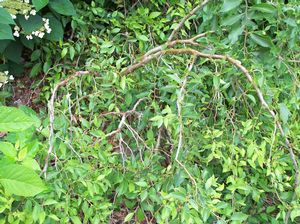Printed at http://www.quackingrassnursery.com/index.cfm/
Ulmus pumila 'Dwarf Weeper'
Siberian Elm
Plant Type:
TREESUlmus pumila ‘Dwarf Weeper’ – This is a strictly weeping plant, at least it has been for us. This form of the Siberian Elm may possibly do some mounding but if you desire a more vertical posture to achieve a wanted height, stake it; then when it has achieved the height you desire let it do what it does best: cascade. The winter form of this small tree is fascinating with gnarled, crooked wood and gently zigzagging branchlets surrounded by a pale brown bark with warm tan lenticels. The bark exudes a white gold color with a silvery sheen which captures and reflects light. Blackish brown globose buds expand in early spring. Clustered flowers stud the stems – more fascinating than beautiful. Rounded elm seeds follow which do modestly decorate the tree. Leaves may become golden brown in some autumns. This would make an interesting choice for an embankment or as a forward ground covering plant to taller background shrubs and evergreens in a larger landscape. 'Dwarf Weeper' might be an interesting bonsai candidate. It may be staked and trained up to a 7-foot specimen. Ulmus pumila ‘Dwarf Weeper’ tolerates tough conditions. Cutting grown.
Height:
1-3 FtSpread:
8-10 FtColors:
Bronze / Brown, GreenCharacteristics and Attributes for Ulmus pumila 'Dwarf Weeper'
Season of Interest (Flowering)
- Early Spring
Season of Interest (Foliage)
- Spring / Summer / Autumn
Interesting Bark
- Architectural
- Weeping Form
- Lenticels
- Contorted
Autumn Interest
- Autumn Leaf Color
Nature Attraction
- Deer Resistant
Light
- Full Sun
Attributes
- Drought Tolerant
- Specimen
- Rock Garden
Growth Rate in the Garden
- Medium
Soil
- Average
- Draining
- Adaptable
Origins
- Garden Origin
Propagated By
- Cutting Grown



